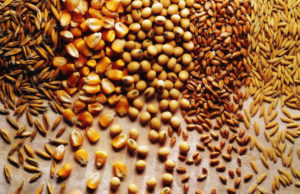 Grain futures advanced on Tuesday with corn rebounding from Tuesdays 34-month low as some investors covered short positions. Meanwhile, wheat gained as Japan lifted the suspension on Oregon wheat imports as a system was introduced that will detect the unapproved strain before the cargo is shipped from the U.S.
Grain futures advanced on Tuesday with corn rebounding from Tuesdays 34-month low as some investors covered short positions. Meanwhile, wheat gained as Japan lifted the suspension on Oregon wheat imports as a system was introduced that will detect the unapproved strain before the cargo is shipped from the U.S.
On the Chicago Board of trade, wheat futures for September delivery traded at $6.5688 a bushel at 8:16 GMT, up 0.84% on the day. Prices held in range between days high and low of $6.5875 and $6.5013 a bushel respectively. The grain settled 0.21% higher on Monday, extending this weeks advance to over 1.1% after tumbling 4.7% during the preceding two.
Wheat was supported as Japan lifted a two-month suspension on Oregon white wheat after an unauthorized genetically modified strain was detected growing in Oregon. The Asian country bans sales of food that contains genetically modified crops, which havent been tested and confirmed safe. Japan has now established a system to detect the unapproved strain before shipment from the U.S. The health ministry will also test the imported grain upon arrival.
Spokesman Fumihiro Michikura by phone for Bloomberg: “We will restart tenders to import western-white wheat on Aug. 1, while purchases of soft-white wheat for livestock feed are planned to resume on Aug. 7.”
The Asian nation imports 90% of the wheat it needs and 60% of total food. Japan already purchased earlier in the month 23 963 tons of club wheat grown in Washington state, 1,497 tons of Australian premium-white and 1,710 tons of U.S. soft-red winter.
In its weekly crop progress report on Monday, the USDA said that winter wheat harvesting narrowed its gap to last years pace. As of July 28, 81 of the nations crop was harvested, compared to 75% a week earlier and 86% in 2012. This was also 1% below the five-year average of 82%.
As for the spring wheat crop, heading advanced by 9% to 94% as of last week, below the five-year average of 95% and last years 99% during the comparable week. Crop condition was overall better compared to last season. As of July 28, 6% of the crop was rated very poor-poor, compared to 11% a year earlier. Results in the “Fair” category were equal at 26% and as for the premium quality, 68% was categorized as “Good” and “Excellent”, above 2012s 63%.
Corn rebounds from a 34-month low
Meanwhile, corn rebounded from a 34-month low as some investors covered short positions, or wagers prices will fall. On the Chicago Board of trade, corn futures for September delivery traded at $4.9313 a bushel at 8:16 GMT, up 0.72% on the day. Prices ranged between days high and low of $4.9338 and $4.8963 a bushel respectively. The grain settled 0.54% lower on Monday, a sixth consecutive daily loss, but has so far advanced 0.3% this week after plunging 9.48% the previous one.
Tetsu Emori, chief fund manager at Astmax Asset Management Inc. in Tokyo, said for Bloomberg: “This is some short-covering after the sharp drop. The weather conditions in July and August are the most important factors for the market. It’s difficult to see a higher price at the end of the summer.”
Corn futures lost 32% this year as the U.S. Department of Agriculture confirmed expectations for reduction in the total output to 13.95 billion bushels, down from 14.005. However, this is still an all-time record high and is 29% higher than last year’s drought damaged crop. This year’s global stockpiles are projected to rise to 150.97 million tons by the end of the 2013-2014 marketing year, 22% more than the previous period.
In its weekly crop progress report on Monday, the USDA said corn silking advanced to 71% as of July 28 from 43% a week earlier. This was slightly below the five-year average of 75% but well under the same week last years 93%.
As for the corn condition, the crop was of the same quality like a week before but a lot better than last years drought damaged crop. As of July 28, 11% was categorized as “Very poor” and “Poor”, well below 2012s 48%. Meanwhile, 26% of the crop fell in the “Fair” category compared to 28% a year earlier. As for the premium quality, 63% was rated good-excellent, well above last years 24% during the comparable week.
Soybeans gain
Soybeans also gained on the day and traded at $12.7688 a bushel at 8:15 GMT, up 0.38%. Prices held in range between days high of $12.7813 and $12.6613 a bushel respectively. The grain fell 9.39% last week and has declined more than 5% during the current one as favorable weather conditions in the U.S. boosted crop prospects.
The oilseed has fallen more than 11% so far this year as the USDA projected domestic output will jump to a record 3.42 billion bushels, which would boost global inventories by 20% to an all-time record high of 74.1 million tons. Goldman Sachs’s 12-month price estimate for soybeans remained at $11 per bushel last week.
The USDA said in its weekly crop progress report on Monday that soybeans blooming advanced last week but was still below last years pace. As of July 28, 65% of the crop had bloomed, compared to 46% a week earlier and the five-year average reading of 74%. During the comparable week last year, 87% of the crop had bloomed.
As for the soybeans condition, it was almost the same compared to the preceding week and far better than last years quality. As of July 28, 9% of the crop was rated very poor-poor, compared to 37% in 2012. Meanwhile, 28% of soybeans were categorized as “Fair”, below last years 34%. As for the premium quality, 63% of the crop was rated good-excellent, compared to 29% during the comparable week in 2012.





